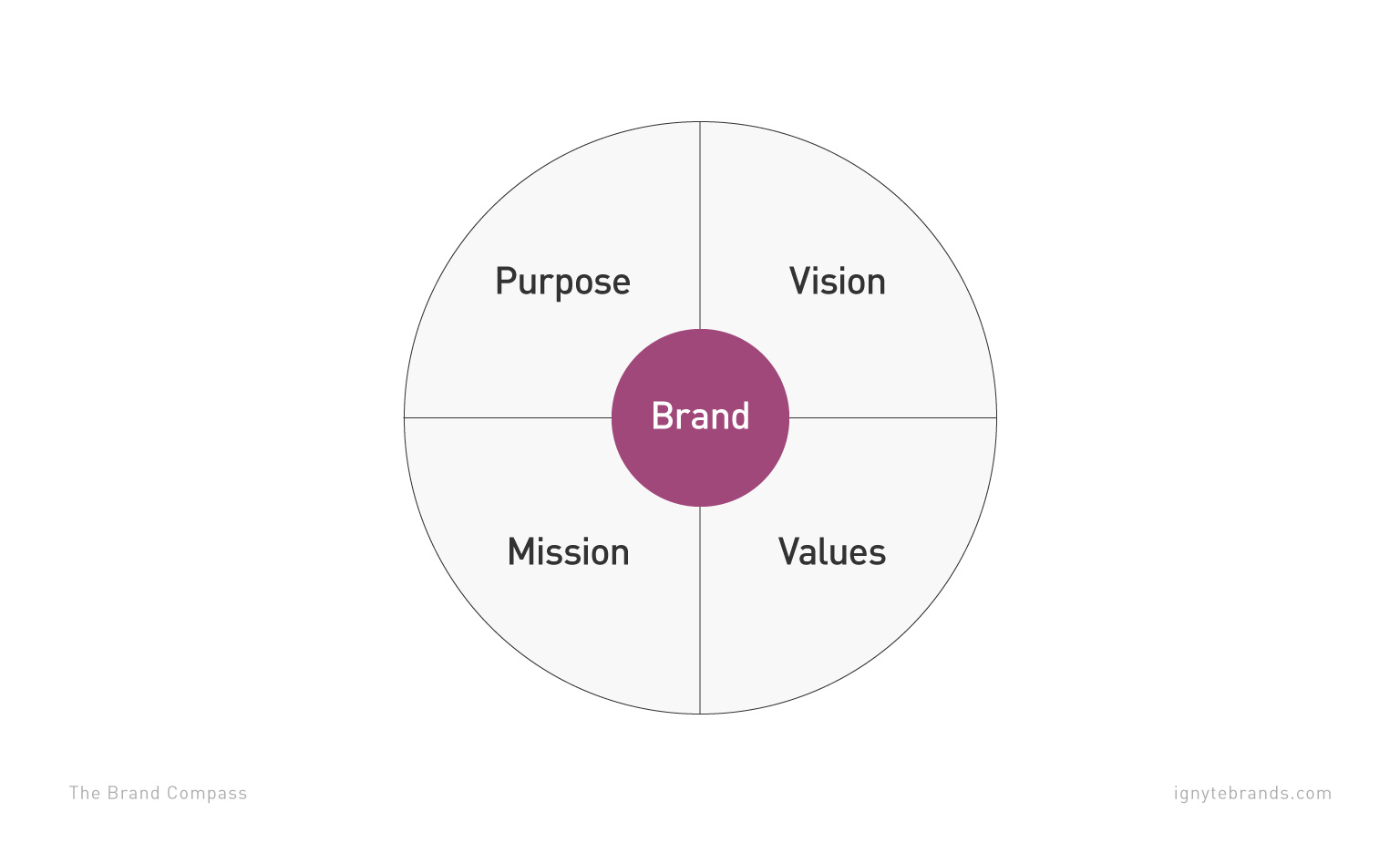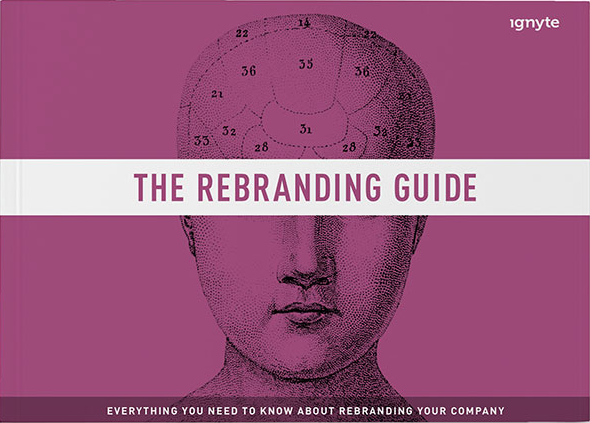If ever there were an invaluable tool for the strategic direction of your business, it is the brand compass.
A four-part strategic messaging system outlining why you exist as an organization, where you’re going, how you plan to get there, and principles that guide your decisions along the way, the brand compass is critical for both internal and external brand alignment.
Below, we’ll take a look at exactly what we mean by a brand compass and why your business needs one. We’ll also dive into each of the brand compass’s four components to see why they’re so important to your business’s success.
CONTENTS
- What is a Brand Compass?
- Why Your Business Needs a Brand Compass
- Purpose Statement
- Vision Statement
- Mission Statement
- Core Values
- The Takeaway
What is a Brand Compass?
A brand compass is a strategic messaging system incorporating four essential ideas behind a brand’s positioning and culture: purpose, vision, mission, and values.
A cornerstone of brand strategy, the brand compass (or branding compass) is usually the result of a thorough brand positioning process, ideally informed by the data and insights that come from brand research.
Why Your Business Needs a Brand Compass?
A well-defined brand compass serves as the foundation for successful brand-building initiatives, ensuring consistent messaging across all touchpoints. Its components represent a cross-section of the most profound truths about your brand.
Think of your brand compass as a tool to focus your business planning and decision-making—especially during difficult times or periods of high growth.
Imagine you’re in the midst of, say, a recession or global pandemic, and your company desperately needs to find new ways to generate revenue. Before you go adding new products or services, it’s important to consult your brand compass to see if these brand extensions align with the strategic direction you’ve defined with your brand compass.
If they don’t, you should think long and hard about why you’re considering adding these offerings and what they will mean for the integrity of your brand.

Your brand compass should guide you in everything from launching a new marketing campaign to taking on new strategic partners to hiring new employees.
All of your internal stakeholders—employees, leadership, board members—should be familiar with your brand compass, especially those tasked with creating brand messaging or shaping brand touchpoints (think marketing and communications departments).
In this way, the brand compass is a critical tool for internal brand alignment, that is, ensuring employees understand your brand from the inside out so they can provide a cohesive brand experience for your customers.
Let’s take a closer look at the four integral components of the brand compass template.
One thing to note before we get started: The distinction between purpose, vision, and mission is both critically important and widely disagreed upon. It seems like every article on the topic has a different definition of these terms. What’s imperative is that you know what each of them means for your brand. Here’s how we define them.
Purpose Statement
Purpose is the reason your company exists beyond making a profit. It is at the center of the brand compass and answers the most profound question your organization faces: why?
Your brand’s purpose statement should be dynamic and motivational. It should connect with the heart as well as the head. Your purpose encapsulates your brand’s impact on the lives of those you serve—be they customers, students, patients, or the community at large.
Questions to ask when formulating your brand’s purpose:
- Beyond making money, why do we do what we do?
- What do we value most?
- What are we most passionate about?
- What drives us as an organization?
- What does the world need most that we are uniquely able to provide?
Purpose statement examples:
- TED: Spreading ideas.
- Disney: To make people happy.
- Smithsonian: The increase and diffusion of knowledge.
- The Nature Conservancy: To leave a sustainable world for future generations.
- Nike: To bring inspiration and innovation to every athlete in the world.
Vision Statement
Your vision statement describes the desired end-state toward which your brand is headed. It’s the ideal world your brand hopes to bring about. Your vision should be lofty—even audacious.
For nonprofits, a vision statement often describes a world in which their services are no longer necessary. If Oxfam was able to achieve their vision of “a just world without poverty,” they’d be out of business. But that’s the idea.
Think of your vision as an inspirational story your brand’s leader would tell to rally the troops. It should be clear and simple, avoiding elaborate language and buzzwords—a story that anyone associated with your brand could easily explain.
Questions to ask when setting your brand’s vision:
- What change do we hope to affect in the world?
- Whom does our organization serve?
- What problem are we looking to solve?
- What is our desired end-state?
- What would success look like?
Sample vision statements:
- Oxfam: A just world without poverty.
- Habitat for Humanity: A world where everyone has a decent place to live.
- IKEA: To create a better everyday life for the many people.
- CVS Caremark: To improve the quality of human life.
Mission Statement
Your mission statement is another key component of the brand compass. Think of it as your brand’s roadmap. It charts the route to your vision by describing what you’re going to do, how you’re going to do it, whom you’re doing it for, and why you’re going to do it.
Your mission should be a self-assured assertion of your plan, bolstering confidence in your brand’s expertise. It defines both the product or service you provide and the level of quality with which you’re committed to providing it.
Questions to ask when formulating your brand’s mission:
- What do we do?
- How do we do it?
- Whom do we do it for?
- Why do we do it?
Sample mission statements:
- Mayo Clinic: To inspire hope and contribute to health and well-being by providing the best care to every patient through integrated clinical practice, education and research.
- Patagonia: Build the best product, cause no unnecessary harm, use business to inspire and implement solutions to the environmental crisis.
- Feeding America: To feed America’s hungry through a nationwide network of member food banks and engage our country in the fight to end hunger.
- NPR: To work in partnership with member stations to create a more informed public – one challenged and invigorated by a deeper understanding and appreciation of events, ideas and cultures.

Core Values
Your brand’s core values are the principles on which your company culture is founded. They outline what is most important to your organization—from a moral, ethical, and philosophical perspective.
It’s critical that your organization has consensus on what matters most—not only to its leadership and staff, but also to its customers. Alignment your core values and those of who you serve is paramount. Nothing is as important to the relationship between a brand and its customers as trust. And customers trust a brand that shares their values. That’s why core values are an indispensable part of the brand compass.
Questions to ask when formulating your core values:
- What do we stand for?
- What are we most proud of?
- What are the principles we won’t sacrifice for anything?
- What is most important to those we serve?
- How would we like to be viewed by others?
Core values examples:
The following are the values that inspire and motivate us here at Ignyte:
Excellence or nothing.
We settle for nothing less than the best in everything we do.
Forever learning and growing.
We continually strive to be better versions of ourselves.
Courageous and driven.
We aren’t afraid to take risks in the pursuit of excellence.
Authentic at all costs.
We are true to ourselves and celebrate our differences.
The Takeaway
It’s important to remember that the brand compass doesn’t purport to represent the totality of your positioning framework. There are other elements such as brand personality, brand promise, competitive differentiation, and more, which aren’t captured by in the brand compass.
What the brand compass does represent is the core tenets of your brand. And if you’re navigating with these fundamental principles as your guide, you can be sure your business is charting a course towards real and lasting success.












